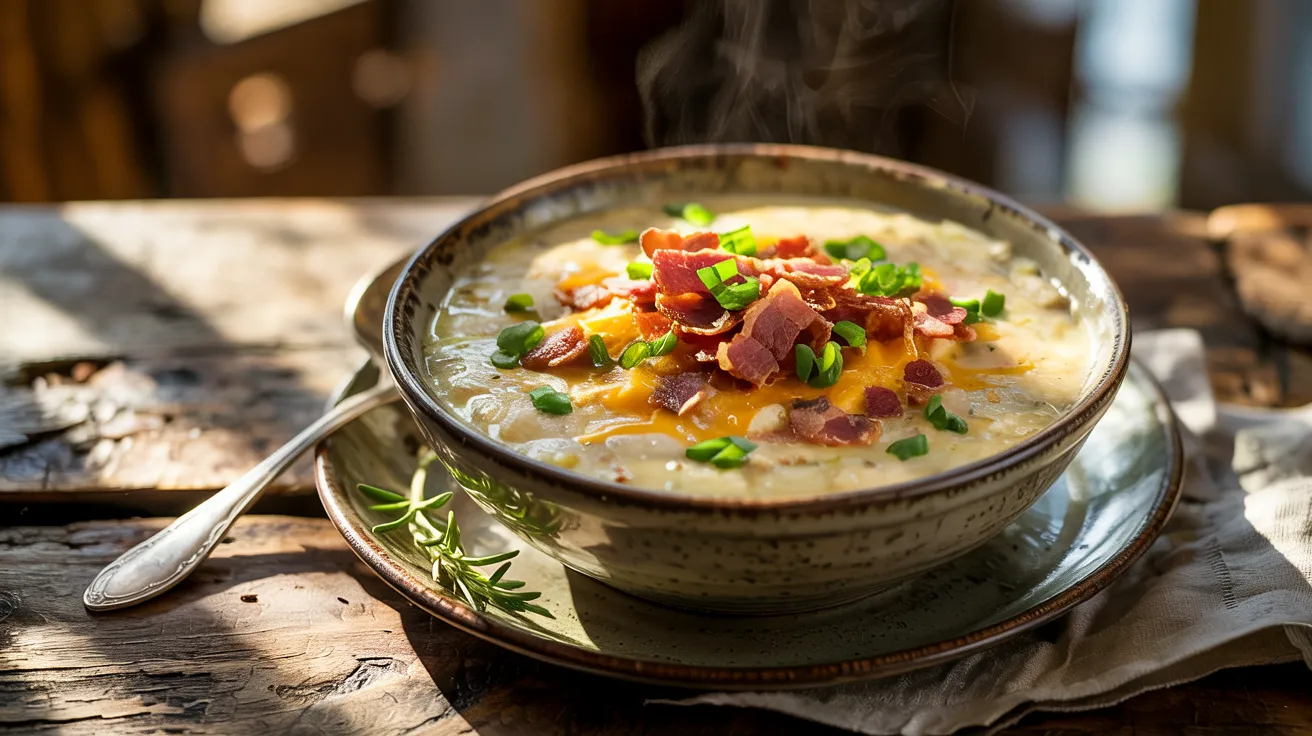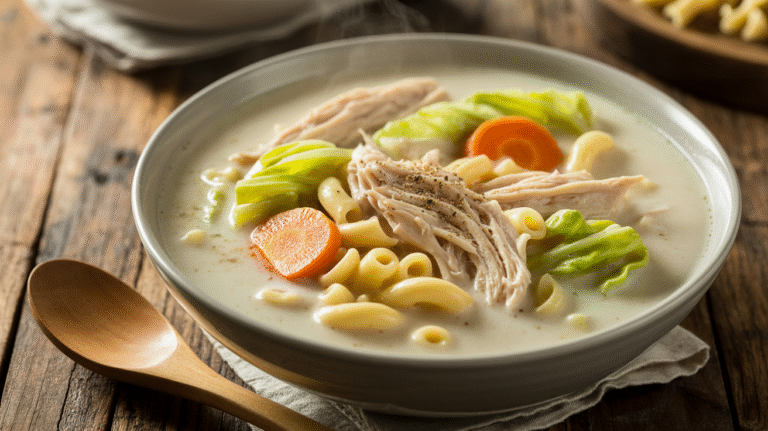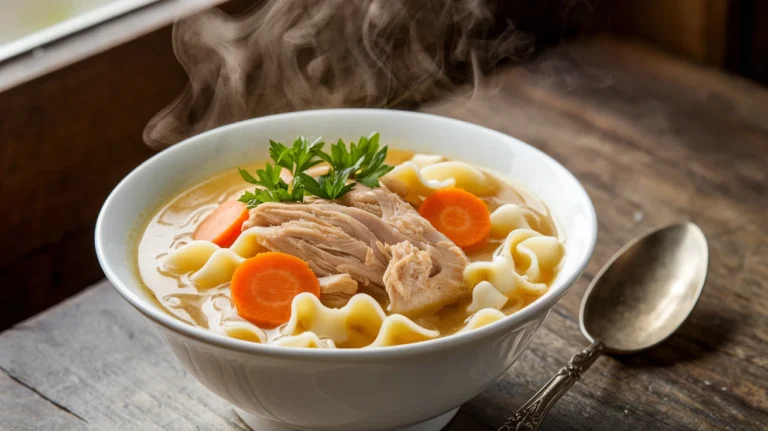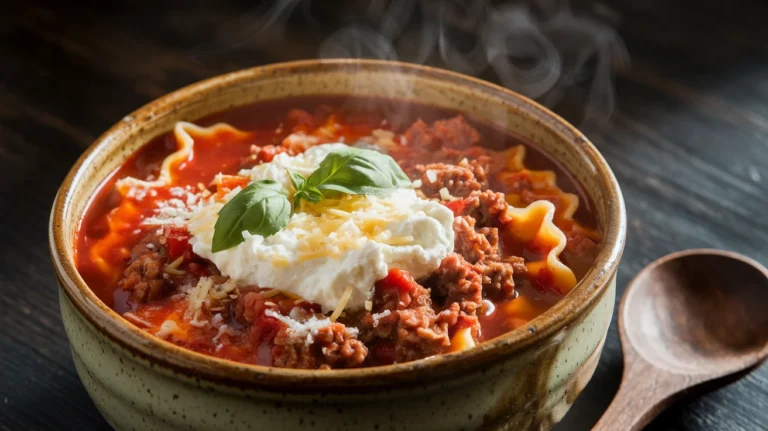This rich and creamy loaded baked potato soup brings all the flavors of your favorite baked potato into one incredible bowl. Perfect for beginners, this loaded baked potato soup recipe uses simple techniques and everyday ingredients to create restaurant-quality results that will warm your soul and satisfy your cravings.
Recipe Quick Facts
SERVES: 4 | PREP: 20 MIN | COOK: 25 MIN | TOTAL: 45 MIN
Ingredients You’ll Need
Base Ingredients
| Ingredient | Amount | Notes |
|---|---|---|
| Russet potatoes | 2 lbs | Peeled and cubed |
| Butter | 4 tbsp | Unsalted preferred |
| Yellow onion | 1 medium | Diced |
| Garlic cloves | 3 large | Minced |
| All-purpose flour | 1/4 cup | For thickening |
| Chicken broth | 4 cups | Low-sodium |
| Heavy cream | 1 cup | Room temperature |
| Sour cream | 1/2 cup | Plus extra for serving |
Loaded Toppings
| Ingredient | Amount | Notes |
|---|---|---|
| Bacon strips | 8 strips | Thick-cut works best |
| Sharp cheddar cheese | 1 1/2 cups | Freshly grated |
| Green onions | 4 stalks | Chopped |
| Salt | 1 tsp | Or to taste |
| Black pepper | 1/2 tsp | Freshly ground |
Complete Step-by-Step Instructions for Perfect Loaded Baked Potato Soup
Phase 1: Preparation and Bacon Cooking (10 minutes)
Step 1: Prepare Your Workspace Start by gathering all your ingredients on your counter. This cooking method, called “mise en place,” means everything in its place. You’ll work more efficiently and avoid mistakes when everything is ready to go. Get out your largest pot or Dutch oven – you’ll need at least 6 quarts of space for this loaded baked potato soup.
Step 2: Cook the Bacon Perfectly Place your 8 bacon strips in your cold Dutch oven. Don’t preheat the pot first – starting with cold metal allows the bacon fat to render slowly and evenly. Turn heat to medium and let the bacon cook for 6-8 minutes, flipping halfway through. You’ll hear gentle sizzling – if it’s popping violently, turn the heat down. The bacon is ready when it’s golden brown and crispy. Why this matters: Properly rendered bacon fat creates the flavor foundation for your entire soup.
Step 3: Save That Precious Bacon Fat Using tongs or a slotted spoon, transfer the crispy bacon to a paper towel-lined plate. Don’t drain all the fat! Measure out exactly 2 tablespoons of bacon fat and leave it in your pot. Pour off any excess fat (save it for cooking eggs later – it’s delicious). Beginner tip: If you accidentally pour out too much fat, add 1 tablespoon of butter to make up the difference.
Step 4: Prep Your Potatoes Like a Pro While the bacon cools, wash and peel your 2 pounds of russet potatoes. Cut them into 1-inch cubes – use a ruler the first few times until you get the hang of it. Keep the pieces uniform so they cook evenly. Pro tip: Cut one potato first, then use those pieces as a size guide for the rest. Place cut potatoes in a bowl of cold water to prevent browning.
Phase 2: Building Your Soup Base (8 minutes)
Step 5: Cook the Aromatics Heat your pot with the bacon fat over medium heat for 30 seconds. Add your diced onion (about 1 cup when diced). Cook for 3-4 minutes, stirring every minute with a wooden spoon. The onions are ready when they look translucent (you can almost see through them) and smell sweet. Visual cue: They should have lost their sharp white color and become soft. Beginner mistake to avoid: Don’t rush this step by using high heat – burnt onions taste bitter.
Step 6: Add Garlic at the Right Moment Add your 3 minced garlic cloves to the pot with the onions. Stir constantly for 30-60 seconds until you smell that amazing garlic aroma filling your kitchen. Critical timing: Garlic cooks much faster than onions, so it goes in second. If it turns brown, it’s burnt and will taste bitter – start over if this happens.
Step 7: Create Your Thickening Roux Sprinkle the 1/4 cup flour evenly over your onion and garlic mixture. Using your wooden spoon, stir constantly for 1-2 minutes. The mixture will look pasty and clump together – this is normal! You’re cooking out the raw flour taste and creating a base that will thicken your soup beautifully. What to look for: The flour should smell toasty, not raw, and the mixture should be lightly golden.
Phase 3: Adding Liquid and Potatoes (15 minutes)
Step 8: Add Broth Without Creating Lumps This step separates beginners from confident cooks. Slowly pour in 1 cup of chicken broth while whisking constantly with a wire whisk. The mixture will bubble and steam – don’t panic! Keep whisking until smooth. Then add the remaining 3 cups of broth more quickly, still whisking. Why this technique works: Adding liquid gradually prevents flour lumps from forming.
Step 9: Add Potatoes and Bring to a Boil Drain your cubed potatoes and add them to the pot. The liquid should cover the potatoes by about 1 inch. Turn heat to medium-high and bring the mixture to a rolling boil – you’ll see big bubbles breaking the surface consistently. Safety note: The mixture may splatter, so have a lid nearby to partially cover if needed.
Step 10: Simmer Until Potatoes Are Perfect Once boiling, reduce heat to medium-low until you see gentle bubbling around the edges – this is a proper simmer. Cook uncovered for 12-15 minutes. Test for doneness: Pierce the largest potato piece with a fork. It should slide in easily with no resistance, like cutting through butter. Timing tip: Start checking at 10 minutes – overcooked potatoes get mushy.
Phase 4: Creating the Creamy Loaded Baked Potato Soup Texture (8 minutes)
Step 11: Mash for Perfect Texture Remove pot from heat temporarily. Using a potato masher, gently mash about half the potatoes right in the pot. Technique: Press down and twist slightly, then lift and move to another spot. Don’t over-mash – you want some chunks for texture. Visual goal: Your soup should look thick and chunky, not smooth like baby food.
Step 12: Add Cream Without Curdling Return pot to low heat – this is crucial! In a measuring cup, stir together your 1 cup heavy cream and 1/2 cup sour cream until smooth. Slowly pour this mixture into your soup while stirring gently. Temperature warning: If the heat is too high, the dairy will curdle and look like cottage cheese. If this starts happening, remove from heat immediately and whisk vigorously.
Step 13: Melt Cheese Like a Professional Remove the pot from heat completely. Add 1 cup of your grated sharp cheddar cheese (save 1/2 cup for topping). Stir gently until the cheese melts completely – the residual heat will do this perfectly. Why remove from heat: Cheese proteins seize up and get stringy when exposed to direct heat. Visual cue: Your soup should be smooth and coat the back of a spoon.
Phase 5: Final Seasoning and Assembly (2 minutes)
Step 14: Season Your Loaded Baked Potato Soup Taste your soup with a clean spoon. Add salt and black pepper gradually – start with 1/2 teaspoon salt and 1/4 teaspoon pepper, then adjust. Remember: Bacon and cheese are already salty, so you might need less salt than you think. Taste again after each addition.
Step 15: Add Bacon and Final Touches Crumble your crispy bacon into bite-sized pieces. Stir half the bacon into your soup, reserving the rest for garnish. Your loaded baked potato soup should be thick enough to coat a spoon but still pourable. If too thick, add chicken broth 1/4 cup at a time.
Chef’s Notes for Perfect Loaded Baked Potato Soup
Potato Selection: Russet potatoes are essential for this loaded baked potato soup recipe because they have high starch content that breaks down and naturally thickens the soup. Waxy potatoes like red or Yukon won’t give you the same creamy texture.
Temperature Control: The secret to smooth, non-curdled soup is gentle heat. Once you add dairy, never let the soup boil again – keep it at a gentle simmer or lower.
Cheese Quality: Pre-shredded cheese contains anti-caking agents that can make your soup grainy. Grate your own cheese for the smoothest loaded baked potato soup.
Make-Ahead Success: This soup tastes even better the next day! The flavors meld beautifully overnight, making it perfect for meal prep.
Nutrition Information (Per Serving)
- Calories: 420
- Protein: 18g
- Carbohydrates: 32g
- Fat: 26g
- Fiber: 3g
- Sodium: 890mg
Creative Loaded Baked Potato Soup Variations
Broccoli Loaded Version: Add 2 cups of steamed broccoli florets during the last 5 minutes of cooking for extra nutrition and a pop of green color.
Cauliflower Twist: Replace half the potatoes with cauliflower florets for a lower-carb loaded baked potato soup that’s just as satisfying.
Seafood Style: Skip the bacon and fold in cooked shrimp or crab meat for an elegant coastal twist. Our Finnish salmon soup offers similar seafood inspiration.
Leek Enhancement: Substitute leeks for the onion to create a more sophisticated flavor profile, similar to our beloved potato leek soup recipe.
Storage & Reheating Your Loaded Baked Potato Soup
Refrigerator Storage: Cool your loaded baked potato soup completely before transferring to airtight containers. Store for up to 4 days. The soup will thicken as it cools – this is completely normal!
Freezing Guidelines: Freeze portions for up to 3 months in freezer-safe containers. Leave 1 inch of headspace for expansion. Note that dairy-based soups may separate slightly when thawed.
Reheating Instructions: Warm gently over low heat, stirring frequently to prevent scorching. Add chicken broth or milk to thin if needed. Never microwave on high power – use 50% power and stir every minute.

Troubleshooting Your Loaded Baked Potato Soup
Problem: Soup is too thin after cooking Solution: Mix 2 tablespoons flour with 1/4 cup cold milk to create a smooth slurry. Whisk into simmering soup and cook 5 minutes until thickened.
Problem: Cheese clumped instead of melting Solution: Remove soup from all heat before adding cheese. The residual heat should melt it smoothly. If cheese has already clumped, blend a portion of the soup until smooth.
Problem: Soup tastes bland despite following recipe Solution: Add salt gradually, then brighten with a splash of white wine vinegar or fresh lemon juice. Sometimes acid is what bland soup needs.
Problem: Cream curdled and looks chunky Solution: Remove from heat immediately and whisk vigorously. For severe curdling, strain through a fine mesh sieve and gently reheat the smooth portion.
Problem: Soup is too salty Solution: Add 1 peeled, diced raw potato and simmer 10 minutes to absorb excess salt. Remove potato pieces before serving.
Essential Equipment for Loaded Baked Potato Soup
- Large Dutch oven (6-quart minimum for proper cooking space)
- Potato masher (for perfect chunky texture)
- Wire whisk (prevents lumps when adding liquid)
- Sharp chef’s knife (for efficient chopping)
- Large cutting board (safe food prep)
- Measuring cups and spoons (accuracy matters)
- Wooden spoon (won’t scratch your pot)
- Ladle (clean serving)
Organized Shopping List
Dairy Section
- Heavy cream (1 cup needed)
- Sour cream (16 oz container)
- Sharp cheddar cheese block (8 oz for fresh grating)
- Unsalted butter (1 stick needed)
Produce Section
- Russet potatoes (2 lbs)
- Yellow onion (1 medium)
- Fresh garlic (1 bulb)
- Green onions (1 bunch)
Meat Department
- Thick-cut bacon (1 lb package)
Pantry Staples
- All-purpose flour
- Low-sodium chicken broth (32 oz carton)
- Salt and black pepper
Five Success Secrets for Perfect Loaded Baked Potato Soup
1. Temperature Management: Bring dairy ingredients to room temperature 30 minutes before cooking. Cold dairy added to hot soup is more likely to curdle and ruin your loaded baked potato soup.
2. Bacon Fat Balance: Use exactly 2 tablespoons of rendered bacon fat – not more, not less. Too much makes greasy soup, too little sacrifices that essential smoky flavor.
3. Gentle Mashing Technique: Mash potatoes lightly and leave visible chunks. Over-mashing creates an unpleasant gluey texture that resembles wallpaper paste.
4. Cheese Addition Timing: Always remove your loaded baked potato soup from direct heat before adding cheese. Gentle residual heat melts cheese perfectly without causing it to seize.
5. Final Taste Adjustment: Your finished soup should taste like the most incredible baked potato you’ve ever eaten. Don’t skip the final seasoning step – proper salt and pepper balance transforms good soup into unforgettable soup.
Serve your homemade loaded baked potato soup immediately in warmed bowls, topped with remaining crispy bacon, extra cheese, and chopped green onions. Each spoonful delivers the perfect balance of creamy comfort and bold flavors that will have your family begging you to make this loaded baked potato soup recipe again and again!




